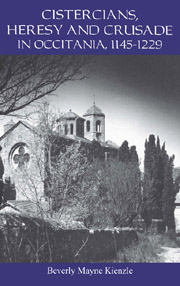Book contents
- Frontmatter
- Contents
- List of Illustrations
- List of Abbreviations
- Chronology
- Preface
- Introduction
- Appendix to Introduction Deconstructing: Close Reading, Rhetorical Criticism, and Historiography of Persecution and Heresy
- 1 The Lord's Vineyard in the Twelfth Century
- 2 Monastic Spirituality and Literature: the Domestic Vineyard
- 3 Bernard of Clairvaux, the 1143/44 Sermons and the 1145 Preaching Mission: From the Domestic to the Lord's Vineyard
- 4 Henry of Clairvaux, the 1178 and 1181 Missions, and the Campaign against the Waldensians: Driving the Foxes from the Vineyard
- 5 Innocent III's Papacy and the Crusade Years, 1198–1229: Weeding the Vineyard
- 6 Hélinand of Froidmont and the Events of 1229: Planting Virtues in the Vineyard
- Conclusion
- Bibliography
- Index
- Title in the series
Introduction
Published online by Cambridge University Press: 12 September 2012
- Frontmatter
- Contents
- List of Illustrations
- List of Abbreviations
- Chronology
- Preface
- Introduction
- Appendix to Introduction Deconstructing: Close Reading, Rhetorical Criticism, and Historiography of Persecution and Heresy
- 1 The Lord's Vineyard in the Twelfth Century
- 2 Monastic Spirituality and Literature: the Domestic Vineyard
- 3 Bernard of Clairvaux, the 1143/44 Sermons and the 1145 Preaching Mission: From the Domestic to the Lord's Vineyard
- 4 Henry of Clairvaux, the 1178 and 1181 Missions, and the Campaign against the Waldensians: Driving the Foxes from the Vineyard
- 5 Innocent III's Papacy and the Crusade Years, 1198–1229: Weeding the Vineyard
- 6 Hélinand of Froidmont and the Events of 1229: Planting Virtues in the Vineyard
- Conclusion
- Bibliography
- Index
- Title in the series
Summary
From 1145 to 1229 Cistercian monks, respected as twelfth-century Europe's holiest and brightest men, embarked on preaching missions against dissident Christians in southern France. The twelfth century witnessed a remarkable upsurge of religious dissent, and preaching offered the medieval Church its most potent instrument of propaganda. Monastic preachers aspired to quell the opposition with words alone, but their sermons also roused recruits for the holy war of crusading on domestic soil as well as abroad. Public preaching was not at all customary for monks: in fact, ecclesiastical tradition and legislation prohibited it. Preaching was reserved instead to the secular clergy – the bishops and priests who espoused the active life in engagement with the world. In contrast, the monastic rule imposed a vow of stability, permanence within the monastery, as part of its design for a life centred on contemplation. Moreover, the Cistercian order established itself on a principle of withdrawal from the world and creation of a model Christian community isolated from the wickedness of society. Despite all this, some Cistercians served as itinerant preachers traversing city and countryside in anti-heretical campaigns. Others plunged even more deeply into the confrontation, accepting posts as bishops and papal legates who aided and even directed the Albigensian Crusade, one of the cruellest medieval wars, and who contributed to establishing procedures of inquisition, codified and expanded in the 1230s. Scholarship on the Albigensian Crusade (1209–29) and the development of the Inquisition has not yet centred on the crucial role of Cistercian prelates and preachers.
- Type
- Chapter
- Information
- Cistercians, Heresy and Crusade in Occitania, 1145–1229Preaching in the Lord's Vineyard, pp. 1 - 15Publisher: Boydell & BrewerPrint publication year: 2001

